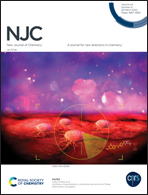Study of the complexation of structurally modified curcumin with hydroxypropyl beta cyclodextrin and its effect on anticancer activity
Abstract
There is evidence that the structural modification of curcumin (CUR) into its pyrazole form (CP) and the complexation of CUR with hydroxypropyl beta cyclodextrin (HPβCD) both improve curcumin's chemical–physical properties and enhance its biological activities. However, making use of both strategies is scarce. This study aims at modifying CUR structurally with hydrazine hydrate and the complexation of the modified CUR with HPβCD, employing a simple protocol, which has not been reported so far. The physicochemical structural features of the prepared compounds have been probed through UV-visible (UV-Vis) spectroscopy, Fourier transform infrared (FTIR) spectroscopy, nuclear magnetic resonance (NMR) spectroscopy, X-ray diffractometry (XRD), differential scanning calorimetry (DSC), thermal gravimetric analysis (TGA) and scanning electron microscopy (SEM). The aqueous solubility of the products was enhanced as examined visibly and by UV-Vis spectroscopy and optical microscopy. The cytotoxicity of the samples in A549 lung cancer cell lines was assessed by MTT assay and cell counting through the trypan blue exclusion method. Negligible colony formation was observed as checked by clonogenic assay in the lung cancer cell lines. Besides being toxic to cancer cell lines, the samples were found to be non-toxic to human peripheral blood mononuclear cells (PBMCs), as revealed by MTT assay.



 Please wait while we load your content...
Please wait while we load your content...